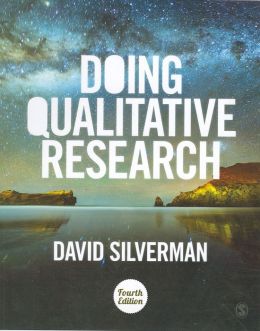
In the fourth edition of his best-selling textbook, David Silverman provides a step-by-step guide to planning and conducting qualitative research. Using real examples from real postgraduate students, the book aims to make it easy to link theory to methods and shows how to move from understanding the principles of qualitative research to doing it yourself. This book will be of great use to students studying research methods, and will give them a thorough and readable introduction to what can sometimes feel like a rather overwhelming subject, concludes Sally Brown.
Doing Qualitative Research: A Practical Handbook. 4th Edition. David Silverman. SAGE Publications. April 2013.
In the fourth edition of his popular best-selling textbook, David Silverman provides a detailed and accessible guide to planning and conducting qualitative research. Aimed at postgraduate students, the book would be just as useful for early career researchers; it has also proven to be a good resource for dipping into from an experienced researcher’s point of view.
Silverman taught for 32 years at Goldsmiths, University of London, and as well as writing and editing a number of well known texts on qualitative research he has also run workshops for students in universities across Europe, Asia, Africa and Australia. The breadth and depth of his experience of both carrying out research and teaching research methods shines through the book, not only in the range of examples he gives, but also in the clear and straightforward way he writes. Throughout the book, he provides examples from a wide range of postgraduate students who, in their own words, tell stories about particular aspects of their research experience. In my own teaching of qualitative research methods, I have found that telling students stories of “real life” research experience helps them to grasp some of the concepts they are hearing about; in particular they seem to enjoy tales of research not going to plan, and find it reassuring to know that things can go wrong but one can still recover. I would expect that students will find the stories that Silverman provides both useful and reassuring; PhD students, who can sometimes feel quite isolated, will undoubtedly benefit from feeling that they are not alone in their research endeavours.
As this is a 4th edition, owners of previous editions, will, as the author notes in his introduction, want to avoid “the usual blather” about what is new in this one. As well as one entirely new chapter, on how to formulate a research question appropriate for qualitative research, there are several new sections, including one on analysing internet data and another on evaluating qualitative research, and some parts which have been substantially rewritten or extended, for example the chapter on the role of theory in qualitative research, the nature of sampling, and how to write a good qualitative research proposal. That section, in chapter 11, will be helpful for students who have come from a more quantitative background and find themselves having to write a qualitative proposal, only to struggle with the way research questions are approached differently by quantitative and qualitative researchers.
One challenge with a text of this nature, in tackling a large and still growing topic such as qualitative research, is how to fit everything into one (affordable) book. Silverman has gone a very long way to addressing this challenge by providing detailed further reading lists and links to a companion website for the book, as well as links to many other useful websites on methods. Thus the book works not only as a companion text for anyone working their way from the very beginning of thinking about a research project through to writing up and publishing, but as a very handy jumping off point into the wide world of qualitative research.
Throughout each chapter, there are exercises to complete which will enable a student to link the theories and techniques that the author has introduced and discussed to their own study; the book could thus be used as a course text for a taught course, or could be used by an individual studying alone. Each chapter is very clearly set out, with the text broken into accessible chunks each headed by a distinct title; links and tips are sprinkled through the chapters, again all clearly indicated and easily found when flipping through the book to find something you know you saw earlier. The “key points” box that ends each chapter is also a handy summary of what has just been presented.
Overall, this new edition is a comprehensive and welcome updating of what was already an essential text. Silverman takes his readers through a substantial and comprehensive introduction to qualitative research and gives them pointers for where to go next. This book will be of great use to students studying research methods, and will give them a thorough and readable introduction to what can sometimes feel like a rather overwhelming subject. As such it deserves its place on reading lists.
——————————————-
Sally Brown is a Research Fellow in the School of Medicine, Pharmacy and Health at Durham University. Her research interests include young people and sexual health, men’s health, and lay knowledge and understanding about diagnosis, risk and decision-making. Read more reviews by Sally.








